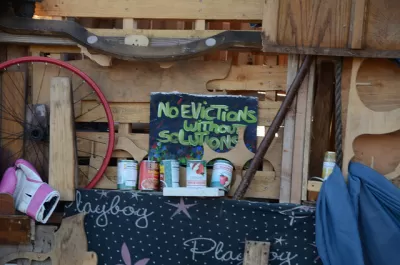The National League of Cities outlines strategies that city leaders can implement at the local level to prevent evictions and increase housing affordability.

A report from the National League of Cities encourages a multi-faceted approach to housing policy that addresses each city's unique needs to prevent evictions and ease the housing crisis as eviction moratoriums expire and tenants and homeowners face eviction and foreclosure. "The report identifies a variety of strategies to prevent evictions, including strengthening just-cause policies, legal assistance, hotlines and financial assistance." Jason Plautz details the report's findings, which signal a need for local governments to develop robust strategies for fighting eviction and making assistance available as well as expunging eviction records to make it easier for people to find housing.
Report co-author Lauren Lowery, NLC director of housing and community development, said cities can be especially effective as convening bodies when it comes to eviction policies. City officials have connections not only in the housing and business community but also to courts, legal aid organizations, state partners and even federal agencies with a role to play in evictions, the report said.
The report recommends creating legal assistance programs to help tenants find and access resources. "According to a report from the New York City Bar Association, 77% fewer eviction warrants were issued when low-income tenants in New York had legal assistance with their eviction cases compared with the outcome when such tenants went without legal assistance."
FULL STORY: To prevent evictions, cities should take a multifaceted approach, NLC report says

Maui's Vacation Rental Debate Turns Ugly
Verbal attacks, misinformation campaigns and fistfights plague a high-stakes debate to convert thousands of vacation rentals into long-term housing.

Planetizen Federal Action Tracker
A weekly monitor of how Trump’s orders and actions are impacting planners and planning in America.

In Urban Planning, AI Prompting Could be the New Design Thinking
Creativity has long been key to great urban design. What if we see AI as our new creative partner?

San Francisco Mayor Backtracks on Homelessness Goal
Mayor Dan Lurie ran on a promise to build 1,500 additional shelter beds in the city, complete with supportive services. Now, his office says they are “shifting strategy” to focus on prevention and mental health treatment.

How Trump's HUD Budget Proposal Would Harm Homelessness Response
Experts say the change to the HUD budget would make it more difficult to identify people who are homeless and connect them with services, and to prevent homelessness.

The Vast Potential of the Right-of-Way
One writer argues that the space between two building faces is the most important element of the built environment.
Urban Design for Planners 1: Software Tools
This six-course series explores essential urban design concepts using open source software and equips planners with the tools they need to participate fully in the urban design process.
Planning for Universal Design
Learn the tools for implementing Universal Design in planning regulations.
Gallatin County Department of Planning & Community Development
Heyer Gruel & Associates PA
JM Goldson LLC
Mpact (founded as Rail~Volution)
City of Camden Redevelopment Agency
City of Astoria
Jefferson Parish Government
Camden Redevelopment Agency
City of Claremont





























